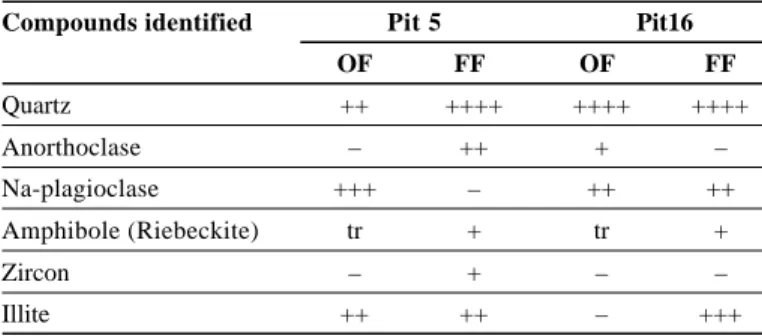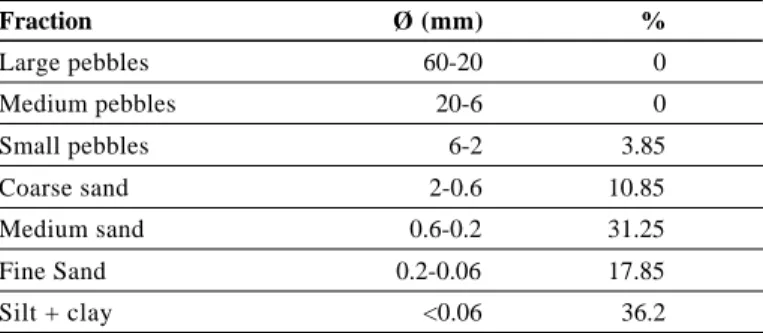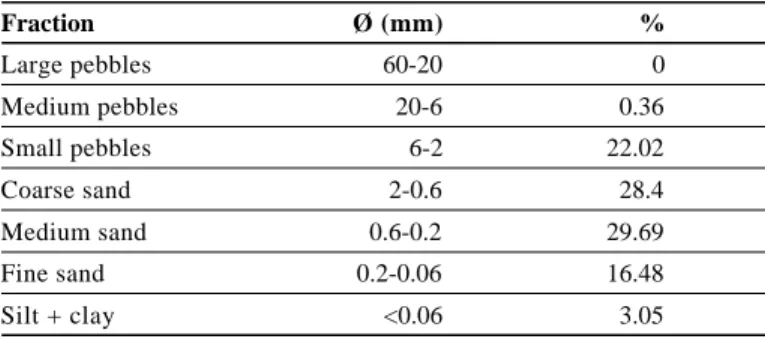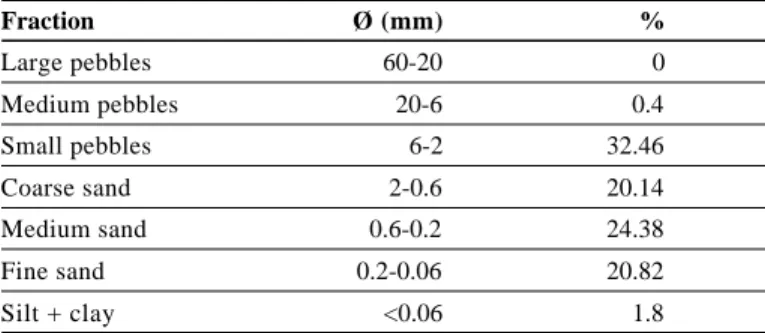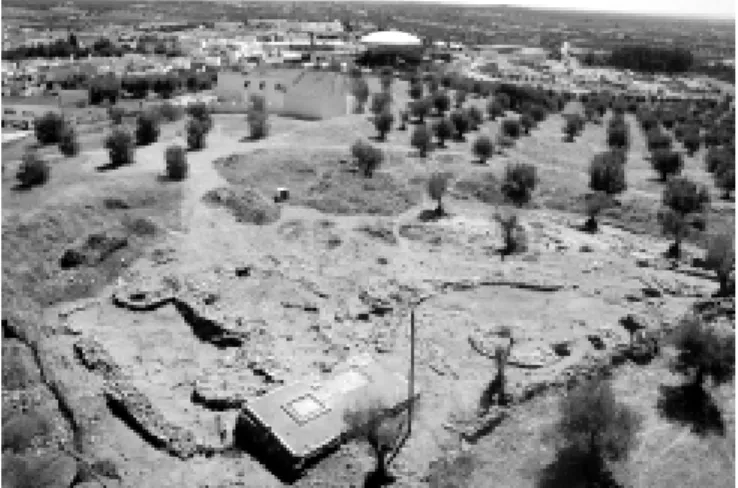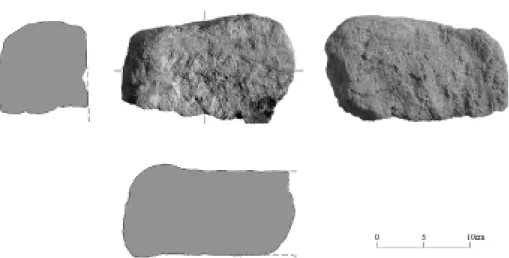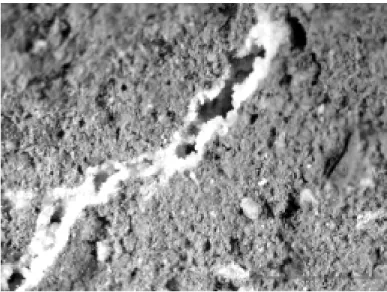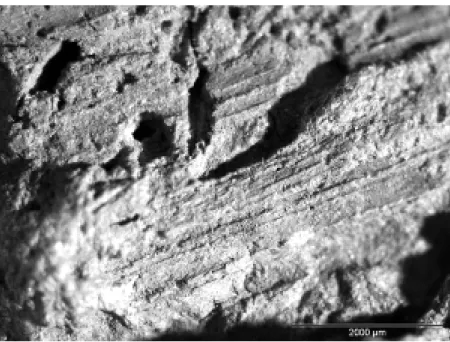CASE STUDIES
by
Patrícia Bruno*, Paulina Faria**, António Candeias*** & José Mirão****
Abstract : Analyzing earth mortar traces from five prehistoric settlements in southern Portugal allowed us to understand some of the building techniques applied in the construction of domestic structures.
Materials were composed of different types of earth traces: small clayish daub fragments coming from the renderings of two neolithic pits at Defesa de Cima 2 (Évora); fragments of clayish mortars with branch prints, coming from covering and filling wood structures, from chalcolithic settlement of São Pedro (Redondo, Évora) and the Bronze Age habitat of Rocha do Vigio 2 (Reguengos de Monsaraz, Évora); manual and perhaps moulded mudbricks, probably belonging to a wall adjacent to a surrounding moat, from chalcolithic settlement of Alto do Outeiro (Beja); big fragments of a hut wall, apparently made of stacked earth, from Alcalar chalcolithic settlement (Portimão, Faro). All materials were burnt by fire, which permitted their conservation until nowadays.
The authors believe these analyses can contribute to deepen the knowledge about pre-historic building techniques, making possible more reliable technological reproductions of habitat structures.
Keywords : Earth mortars; building techniques; pre-historic settlements.
Resumo: O estudo dos vestígios de argamassas de argila provenientes de cinco habitats pré-históricos do Sul de Portugal permitiu reconhecer algumas técnicas de construção aplicadas em estruturas de cariz doméstico. Foram analisados vestígios construtivos de argamassas de diferentes tipos: fragmentos de revestimentos de duas fossas neolíticas do habitat de Defesa de Cima 2 (Évora); fragmentos de argamassas com impressões de ramagens, que possivelmente revestiam estruturas de suporte compostas por engradados de materiais vegetais, provenientes do povoado calcolítico de São Pedro (Redondo, Évora) e do sítio do Bronze Final de Rocha do Vigio 2 (Reguengos de Monsaraz, Évora); fragmentos de adobes manuais, e também de adobes possivelmente moldados, aparentemente pertencentes a um muro adjacente a um fosso do povoado calcolítico de Alto do Outeiro (Baleizão, Beja); grandes fragmentos de argamassas de argila aparentemente provenientes da derrocada da parede maciça de uma cabana do povoado calcolítico de Alcalar (Portimão, Faro). Todos os materiais foram sujeitos a combustão, o que permitiu a sua conservação até à actualidade. Os autores crêem que o desenvolvimento de estudos deste tipo poderá contribuir para aprofundar o conhe-cimento das técnicas de construção pré-históricas e tornar possível a elaboração de reconstituições tecnica-mente mais fidedignas.
Palavras-chave: Argamassas de terra; tecnologias construtivas; povoados pré-históricos.
* UNIARQ, University of Lisbon, Portugal _ pbruno.pat@gmail.com
** Polytechnical Institute of Setúbal and CICC, Portugal _ paulina.faria@estbarreiro.ips.pt
*** Hércules Laboratory and Chemistry Centre, University of Évora and José de Figueiredo Conservation Restoration Laboratory, Institute of Museums and Conservation, Portugal _ candeias@uevora.pt
1. Introduction
The present article is based in a larger research from a PhD thesis in Prehistory, regarding domestic architectures in habitat settlements from southern Portugal and involved the study of structure traces from a considered set of archaeological sites. That study allowed characterizing prehistoric domestic architectures, considering aspects like shape, typology, construction techniques and building materials.
Specifically regarding earth materials, different building techniques were identified: – Molded earth, used on walls;
– Stacked earth, used on walls;
– Earth mortars covering and filling vegetable structures; – Earth mortars binding stone masonry;
– Earth mortars rendering pits; – Mudbricks masonry.
The most antique techniques seem to be molded earth and earth mortars rendering pits, identified since Ancient Neolithic - the first one apparently used on the construction of culinary ovens and the second rendering underground storage bins. The other techniques were all identified from the Chalcolithic period, but, apparently only earth mortars binding stone masonry and covering and filling vegetable structures seem to be used in Bronze Age domestic structures (Bruno, 2007).
Case studies selection was based on technology representativeness for each period and on the existence of relatively well documented domestic structures, as well as the availability of large quantities of samples for study.
The analysed materials were composed of different types of earth traces: small clayish daub fragments coming from the renderings of two neolithic pits at Defesa de Cima 2 site (Évora); fragments of clayish mortars with branch prints, coming from covering and filling of wood structures from the chalcolithic settlement of São Pedro (Redondo, Évora) and the Bronze Age habitat of Rocha do Vigio 2 (Reguengos de Monsaraz, Évora); manual and perhaps moulded mudbricks, probably belonging to a wall adjacent to a surrounding moat, from the chalcolithic settlement of Alto do Outeiro (Beja); big fragments of a hut wall, apparently made of stacked earth, from Alcalar chalcolithic settlement (Portimão, Faro).
All materials were burnt by fire, which permitted their conservation to the present.
2. Territory
The studied area corresponds to current southern Portuguese territory and is limited north by Tagus river, east by Guadiana river, west and south by the Atlantic Ocean.
Plain landscapes predominate, mostly less than 400 m high, with occasional elevations. Geologically, the territory is generically characterized by the presence of Paleozoic metamorphic and igneous rocks (in interior Alentejo region), Mesozoic sedimentary rocks in coastal areas and recent sediments associated to the ancient basins of Tagus and Sado rivers (Ribeiro, 1945). Tagus, Sado and Guadiana are the main rivers of the region.
The climate is typically Mediterranean, with high temperatures, strong insolations and absence of rain in summer. However, in the Atlantic coast, relative humidity is higher
and temperature moderate, comparing to interior Alentejo. The warm and luminous weather goes on until autumn, despite lower temperature and the occurrence of some rain. Generally, rain falls strongly from December to March (ibid.)
Plant life, conditioned by climate, is mainly composed of Mediterranean species: evergreen trees and bushes like cork trees, holm oaks, pine trees (specially stone pines), arbutus trees, heathers, laurels, lentisks, butcher’s brooms, oleanders, canes, rock roses; aromatic plants from dry soils like rosemary, lavender and thyme; planted trees and bushes like almond, fig, carob, orange and olive trees and vineyards (ibid.).
3. Case studies 3.1. Methodology
Generally, samples were selected from units containing materials stratigraphically related with domestic structural traces like pits, hut bottoms, wall bases or post holes. Morphological diversity of samples was also considered as a preponderant factor, in order to characterize different building systems.
Beyond mortars composition study, in some of the cases, possible relations between mortar fragments and associated structures were established, in order to formulate some hypotheses about building systems and to reconstitute architectures.
Methodology used on earth traces from case studies included, in a first stage, samples visual observation, measurement, drawing and photo register; later, some of the samples were observed with stereozoom microscope and subject to granulometric and mineralogical analysis.
Stereozoom microscope observation of the samples was made with an Olympus SZH10 Stereozoom microscope and treated with “CellD” software associated to Color View Soft Imaging System program at the Microstructure Analysis Laboratory of Faculty of Science and Technology, New University of Lisbon.
Granulometric analyses were based on LNEC (National Laboratory for Civil Engineering) procedures E239-1979 (granulometric analyses by wet sieving) and E195-1966 (samples preparation by dry way) and were performed at the Soil Mechanics Laboratory of the Faculty of Science and Technology of Nova University of Lisbon.
The mineralogical composition of the mortars was evaluated by X-ray diffraction (XRD), using a “D8 Discover Bruker-AXS” instrument, operating with Cu-K_ radiation and 40 kV accelerating voltage and 30 mA current. The 2_ range was 3 to 75º, with a step size of 0.02º and step time of 1 s. XRD analysis and phase identification were achieved using “EVA Bruker-AXS” software and “PDF-2 ICDD” database. Overall fractions of mortars were obtained after samples careful disaggregation while fine fractions were obtained by separation in a 106µm sieve, in order to have portions enriched in binder. Mineralogical analyses by X-ray diffraction were made at Hercules Laboratory and Chemistry Department of Évora University.
3.2. Defesa de Cima 2
3.2.1. Location and archaeological intervention
Ancient neolithic habitat of Defesa de Cima 2 is located near Torre de Coelheiros village, in Évora region.
This occupation was implanted over an eruptive rock substrate, mostly composed by granitic quartzodiorites and granodiorites. Soils are brown Mediterranean type, from the weathering of quartzodiorites and granodiorites (SROA, 1967).
Excavations showed a large set of anthropic origin pits, with oval and circular plans, with 0.60 m to 0.90 m of diameter, and maximum conserved deeps until 0.83 m.
Structures were partially destroyed in their top levels. Many of them were interiorly rendered with clay mortars, exposed to combustion after application. Although flora traces have not been found in the pits interior, archaeologists believe that they were used as storage bins (Santos & Carvalho, 2008). Burning interior renderings would provide preservation of stored products, by protecting them from the soil humidity.
3.2.2. Analysis of materials
Analyzed samples were composed by small plaques of clay mortar, with 2.0-3.0 cm of thickness, collected from two pits - pit 5 and pit 16.
Pit 5 (figure 1) had circular plan, with 0.80 m of diameter and 0.83 m of maximum preserved depth; inside, close to the basis, contained imbricate stones with combustion vestiges. Clayish renderings were continuous, surfacing the pit’s lateral walls.
Pit 16 was too much destroyed. It had circular plan, with 0.80 m of diameter and 0.50 m of maximum preserved depth. Only part of lateral renders was preserved.
Morphologically, all samples were composed by small nodules and plaques of various dimensions, with 3.0 cm of maximum thickness. Concave faces of the plaques were smoothed and some of them had finger prints.
Mortars had brown-reddish colors and homogeneous compositions. Traces of organic materials, animal or vegetable fibers were not detected.
Small pores were observed, with diameters up to 1.0 mm. Microfissures were rare and had apertures up to 0.2 mm.
Disaggregation of samples for granulometric analyses was quite easy because in the interior, fragments were almost unburnt, showing different degrees of burning.
Granulometric analyses (table 1) showed similar compositions for both samples: fine aggregates were dominant (84.55% and 85.74% of sands in samples from pit 5 and pit 16, respectively), followed by binder portions (8.2% and 12.5% of silt and clay, in samples from pit 5 and pit 16, respectively) and large aggregates (7.25% and 1.26% of pebbles, in samples from pit 5 and pit 16, respectively).
Table 1. Defesa de Cima 2: granulometries from pit’s 5 and 16 renderings
Fraction Ø (mm) % - Pit 5 % - Pit 16
Large pebbles 60-20 0 0 Medium pebbles 20-6 0 0.21 Small pebbles 6-2 7.25 1.55 Coarse sand 2-0.6 21.70 25.69 Medium sand 0.6-0.2 50.60 41.05 Fine Sand 0.2-0.06 12.25 19.00 Silt + clay <0.06 8.20 12.50
Table 2 presents the results of X ray diffractometry analysis of samples from pits 5 and 16. Quartz is the predominant phase. Feldspars rich in potassium (Anorthoclase) and sodium (Na-plagioclase) are also present. The presence of amphibole and zircon are compatible in the granitoid character of the soil parent rock. Illite seems to be the dominant clay mineral. Thus the mortar phase composition is based in local soils.
Table 2. Defesa de Cima 2: mineralogical composition of pit’5 and 16
renderings
Compounds identified Pit 5 Pit16
OF FF OF FF Quartz ++ ++++ ++++ ++++ Anorthoclase – ++ + – Na-plagioclase +++ – ++ ++ Amphibole (Riebeckite) tr + tr + Zircon – + – – Illite ++ ++ – +++
OF: overall fraction; FF: fine fraction; ++++: predominant compound; +++: relatively high proportion; ++: medium proportion; +: low proportion; tr: traces; –: not detected
3.3. São Pedro
3.3.1. Location and archaeological intervention
Chalcolithic settlement of São Pedro (figure 2) is located in Redondo village, in Évora district.
Geologically, the area falls in Redondo anti-form. Schists are the predominant rocks in the archaeological site. Surrounding, granitoid rocks are also present – mostly granodiorites and quartzdiorites (SGP, 1986). Local soils are brown Mediterranean type (SROA, 1964).
Archaeological interventions between 2004 and 2009 allowed the identification of a fortified settlement, with occupations dating from 4th and 3rd millennium b.C., developed on five differenced phases. During excavations, many traces of dwellings were found, specially belonging to the settlement’s 3rd and 5th phases.
Most of the analyzed materials – fragments of clay mortars with branches’ prints – were collected from 3rd phase stratigraphic units. Unfortunately, it was not possible to clearly relate them with any of the identified structures.
The 3rd phase corresponded to the abandonment and dismantling of defensive structures from 2nd phase and, apparently, was characterized by an open occupation, mostly composed by constructions made of perishable materials. The most significant domestic structures were: in the North/ Northeast slope, a large rectangular compartment, built over the previous defensive wall and barbican, and several post holes configuring a circular hut, with a great stoned structured fire place; in the South slope, traces of a circular or oval hut and a probable rectangular house (Mataloto & Müller, in press).
3.3.2. Analysis of materials
Analyzed materials were chosen from units that contained fragments of clay mortars with branch prints, considering the following aspects:
– Samples dimensions;
– Branches or other prints, possibly related with support structure elements; – Final surfaces evidences, smoothed or decorated.
Many of the fragments showed branch prints and, simultaneously, on their opposite faces, smoothed surfaces, some of them with finger prints. Those final surfaces had plain, concave and convex forms.
As to dimensions, fragments had maximum thickness of 2.0-8.0 cm and distances between branches and smoothed surfaces about 0.9 cm to 2.6 cm. Branches had parallel, perpendicular and oblique directions between them, with diameters of 0.3 cm to 1.8 cm. Laboratorial analyses were made with fragments from unit 644, which was the one that provided the greatest quantity of materials.
Stereozoom microscope observation showed that mortars were extremely homogeneous and had brown-reddish colors. Traces of organic materials, animal or vegetable fibers were not detected. Mortars had few pores, with diameters up to 1 mm. Microfissures were rare and had apertures up to 0.1 mm.
Samples disaggregation for analyses was extremely difficult, due to high compressive strength as the result of intense combustion.
Granulometric analyses (table 3) showed that mortar was mainly composed by fine aggregates (59.95% of sands), 36.2% of binders and only 3.85% of pebbles.
The only mineral detected is quartz (table 4), in the fine and in the overall fractions. Muscovite and illite are also present.
Table 3. São Pedro: granulometry of sample from unit 644 Fraction Ø (mm) % Large pebbles 60-20 0 Medium pebbles 20-6 0 Small pebbles 6-2 3.85 Coarse sand 2-0.6 10.85 Medium sand 0.6-0.2 31.25 Fine Sand 0.2-0.06 17.85 Silt + clay <0.06 36.2
Table 4 . São Pedro: mineralogical composition of sample from unit 644
Compounds identified OF FF
Quartz ++++ ++++
Muscovite + +
Illite + +
OF: overall fraction; FF: fine fraction; ++++: predominant compound; +++: relatively high proportion; ++: medium proportion; +: low proportion; tr: traces; –: not detected
3.4. Alto do Outeiro
3.4.1. Location and archaeological intervention
The Chalcolithic settlement of Alto do Outeiro is located in Baleizão village, Beja district.
Geologically, the settlement area is in Beja gabbros region, where dioritic-gabbro rocks are dominant. In the closest surrounding area are also present quartz-diorites, porphyry, conglomerates, sandstones, marls with calcareous concretions, clays, gravels, limestone and calcareous tuffs. Soils are clayish, with caulinitic and montmorilonitic clays (SGP, 1992b; Oliveira, 1992).
The settlement was identified and excavated in 2005, due to irrigation system works in the area. Archaeological intervention revealed the existence of a prehistoric habitat surrounded by three undulating moats, possibly supplemented by mudbrick masonry walls. Large quantities of fragmented mudbricks were detected upon the clogging levels of the most exterior moat and an adjacent stone base, with about 0.5 m of thickness. Those mudbricks probably belonged to a wall upon that stone base (Grilo, 2008).
3.4.2. Analysis of materials
Chosen materials were selected from two different clogging levels of the exterior moat (units 90 and 101), containing big fragments and deform nodules of clay mortars from mudbricks.
Materials from unit 90 were composed by several nodules of clay mortar reddish color and a big mudbrick fragment (figure 3).
The four surfaces of the mudbrick fragment were plain, with straight edges, which suggest the use, on its manufacturing, of some kind of mold. One of the faces (the smallest) showed two finger prints that seemed to result from the mudbrick handling in plastic state. The fragment weighed 2.832 kg and measured 17 cm x 14 cm x 6.5 cm, showing two fractured faces.
Materials from unit 101 were also composed by several nodules of clay mortars and a big mudbrick fragment of yellowish color (figure 4). Mudbrick fragments measured about 16 cm x 9 cm x 7 cm and had two fractured faces. The other four faces seemed smoothed, however not plain. Edges were rounded. The fragment weighed 2.476 kg.
Laboratorial analyses were only made with samples from unit 101, clearly similar to mudbrick 729. This similarity was observed with stereozoom microscope, by comparison of several samples from the nodules of the two units and two samples from each mudbrick. Samples disaggregation for analyses was quite easy and showed that fragments were internally unburnt.
Granulometric analyses (table 5) showed that mortar was mainly composed by fine aggregates (74.57% of sands), followed by pebbles (22.38%) and only 3.05% of silt and clay.
Plagioclase and calcite were the predominant minerals (table 6), both in the overall and in the fine fractions of the sample. In the fine fraction, a relatively high proportion of quartz was also detected while, in the overall fraction, low proportions of quartz and of amphibole were registered.
Table 5. Alto do Outeiro: granulometry of mortar from unit 101
Fraction Ø (mm) % Large pebbles 60-20 0 Medium pebbles 20-6 0.36 Small pebbles 6-2 22.02 Coarse sand 2-0.6 28.4 Medium sand 0.6-0.2 29.69 Fine sand 0.2-0.06 16.48 Silt + clay <0.06 3.05
Table 6. Alto do Outeiro: mineralogical composition of a sample from unit 101 Compounds identified OF FF Quartz + +++ Plagioclase (albite) ++++ ++++ Amphibole (Riebeckite) +
-Iron minerals (chamosite, hematite) tr tr
Illite - tr
Smectite - tr
Calcite ++++ ++++
OF: overall fraction; FF: fine fraction; ++++: predominant compound; +++: relatively high proportion; ++: medium proportion; +: low proportion; tr: traces; –: not detected
3.5. Alcalar
3.5.1. Location and archaeological intervention
Alcalar chalcolithic archaeological site is located in Algarve, between Alvor estuary and Monchique Mountain, near the village of Mexilhoeira Grande, Portimão.
The settlement is located in Algarve Barrocal, where sedimentary rocks are dominant. The area corresponding to the pre-historic village is based on a formation of limestone, sandstone and marl-limestone (SGP, 1992a). Soils are red or yellow Mediterranean type, from limestones or dolostones (SROA, 1959).
Besides two surrounding moats, excavations and geomagnetic prospection in Alcalar allowed discovering several domestic structures, mostly composed by hut bottoms, combustion structures and storage bins (Morán, 2001).
Analyzed materials were collected inside a big hut with oval plan, located in the settlement’s central area. They were found upon the hut’s stone base and in its interior and probably belonged to a massive earth wall that fell.
In the hut’s interior existed a fire place, with circular plan on torus form, made of clay mortar.
3.5.2. Analysis of materials
Chosen materials were selected from the pile of fragments found inside the hut (unit 698), with about 1 m3 of volume. Earth mortars had orange colors and showed irregular textures, apparently rich in fine aggregates (sands), with some pebbles of larger dimensions (limestones and shells); almost all fragments showed carbonated aspect, possibly caused by chemical modification of aggregates.
Many samples showed a smoothed face, sometimes with finger prints.
quantities of aggregates than the other analyzed materials and also more heterogenic compositions. Traces of organic materials, vegetable or animal fibers were not observed.
Mortars had some circular and oval pores, with diameters up to 0.5 mm.
As to conservation status, materials showed chemical modification, by generalized presence of calcareous concretions, probably due to water percolation in the fragments interior. Those concretions were mainly associated to large numerous cracks.
Disaggregating samples to granulometric analyses was extremely difficult, due to materials calcification.
Granulometry results (table 8) showed that mortar was predominantly composed by fine aggregates (65.34 % of sands), followed by pebbles (32.86%), and, in less quantity, by binders (only 1.8% of silt and clay).
Table 8 presents X-ray diffractometry analysis of a sample from unit 698. Calcite was the predominant phase and quartz was also present in high proportion. In the overall fraction, hematite and illite were also present.
Table 7 – Alcalar: granulometry from sample ALC5-07, unit 698
Fraction Ø (mm) % Large pebbles 60-20 0 Medium pebbles 20-6 0.4 Small pebbles 6-2 32.46 Coarse sand 2-0.6 20.14 Medium sand 0.6-0.2 24.38 Fine sand 0.2-0.06 20.82 Silt + clay <0.06 1.8
Table 8. Alcalar: mineralogical composition of a sample from unit 698
Compounds identified OF FF
Quartz +++ ++++
Hematite ++ –
Illite + –
Calcite ++++ ++++
OF: overall fraction; FF: fine fraction; ++++: predominant compound; +++: relatively high proportion; ++: medium proportion; +: low proportion; tr: traces; –: not detected
3.6. Rocha do Vigio 2
3.6.1. Location and archaeological intervention
The Final Bronze Age habitat of Rocha do Vigio2 was located in Campinho village, near Reguengos de Monsaraz city, Évora district.
Regarding geology, this is an area of metamorphic rocks Silurian formation, where clayish schists dominate (SGP, 1976). Soils are yellow and brown Mediterraneum type, from schists (SROA, 1965).
Excavation allowed the identification of an oval plan hut, composed by a stone base and a row of slabs of shale, vertically arranged, defining its exterior perimeter (Calado et al., 2002). In its interior, a large quantity of fragments of clay mortars with branch prints were found, probably belonging to the walls and roof of the hut, composed by wood structures.
3.6.2. Analysis of materials
Selection of samples took account, like in São Pedro case, parameters like fragments dimensions, presence of branch prints and the existence of smoothed surfaces. Chosen materials came from stratigraphic units 39, 59, 64 and 67, located in the presumable central area of the hut.
Materials from unit 39 seem to have different compositions. Some of the fragments showed straw traces, apparently added to earth mortars. Generally, all smoothed faces were plain or concaves.
Individual record 1031 (figure 6) had only one branch, with 4.0 cm diameter. Alongside this, the fragment showed a shaped surface, that seems to have made the frame finish of a jamb or lintel of a doorway.
Unit 59 presented the largest number of fragments. Many of them showed smoothed surfaces with finger prints, always planes and concaves.
Branch prints, always opposite to the smoothed ones, measured 0.2-4.0 cm diameter. Many fine branch prints appeared, apparently from reeds. All samples showed straw prints, incorporated into earth mortars.
Individual record 1103 (figure 7) measured 4.7 cm thickness. It showed a plank and four branch prints. The plank with was about 5.0 cm and branches diameter were 1.0-3.7 cm. Two samples from unit 59 were observed with stereozoom microscope (figure 8). Mortars had brown red colors and homogenous composition. Straw prints were observed. Samples showed some circular pores, with diameters up to 0.5 mm; some microfissures were also detected, with apertures up to 0.2 mm.
Disaggregating samples to granulometric analysis was quite easy, which indicates that on the inside, fragments were badly burnt.
Granulometric analysis results (table 9) showed a composition very rich in fine aggregates (70.55% of sands), followed by small pebbles fraction, with 12.9%, and, on less quantity, of binders (8.55% of silt and clay).
Table 10 presents X-ray diffractometry analysis of a sample from unit 59. Quartz was the samples predominant compound, with low proportions of muscovite and illite.
Table 9. Rocha do Vigio 2: granulometry of a sample from unit 59 Fraction Ø (mm) % Large pebbles 60-20 0 Medium pebbles 20-6 0 Small pebbles 6-2 12.9 Coarse sand 2-0.6 32.5 Medium sand 0.6-0.2 30.35 Fine sand 0.2-0.06 15.7 Silt + clay <0.06 8.55
Table 10. Rocha do Vigio 2: mineralogical composition of a sample
from unit U.E. 59
Compounds identified OF FF
Quartz ++++ ++++
Muscovite + +
Illite + +
OF: overall fraction; FF: fine fraction; ++++: predominant compound; +++: relatively high proportion; ++: medium proportion; +: low proportion; tr: traces; –: not detected
3.7. Commentaries to results
The analysis results suggest, in all cases, that mortars were produced with local materials.
Generally, samples morphologies and compositions revealed consistent with the probable building techniques – mortars exclusively used on renderings showed the lowest percentages of pebbles (Defesa de Cima 2); rendering and filling mortars (Defesa de Cima 2, São Pedro, Rocha do Vigio 2) showed highest percentages of clay than the other earth mixtures, used on the construction of monolithic structures (Alcalar) or mudbrick masonry (Alto do Outeiro).
In Alcalar case, in which the building technique was apparently monolithic earth, mortar had less quantity of binders and higher percentage of large aggregates (pebbles, gravel and seashells), similarly to mixtures frequently used on the construction of massive walls, such as those of rammed earth. However, it seems that no casts were used on Alcalar hut walls construction. To clarify still remains the reason why the populations having good clayish soils in the vicinities of Alcalar and Alto do Outeiro chose other soils for their constructions, with low quantities of clay and enriched in calcium carbonate. Perhaps they had an empirical knowledge about the role of calcium carbonate and lime as binder, and used it to produce more resistant mixtures, almost similar to the ones that, in later times, would be called “lime based mortars”.
4. Conclusions and future developments
Archaeological materials exhumed in several prehistoric settlements of southern Portugal show that earth mortars were largely used in the construction of domestic structures. In fact, the abundance of clayish materials in most geographical contexts and the easiness in handling them made earth mortars use extremely frequent in these prehistoric communities.
Anyhow, only earth vestiges exposed to combustion survived until nowadays, which strongly limits the identification of other possible construction techniques, and also the extent of its use.
However, it has been possible to better understand some structures from the studied sites, by adding earth materials to the still unfinished “puzzles” of prehistoric domestic architectures. And based on case studies’ material analyses, it was possible to draw some hypothetical reconstitution models of prehistoric settlements.
Presentation of these reconstitutions is quite important for the process of interpretation and understanding of archaeological prehistoric settlements. From an educational perspective, it facilitates “common” spectator to understand different models and ways of life, hardly understandable by mere observation of archaeological remains.
So, the authors believe that the development and analysis of case studies will help to throw light on our knowledge about technologies of extraction, manufacture and application processes of earth building materials in Prehistory, making technological reproduction of habitat settlements close to the original sites possible.
References
Bruno, P., 2007. Arquitectura de terra na Pré-história – vestígios de estruturas habitacionais, do VI ao II milénio a.C., no Sul de Portugal, in Terra em Seminário 2007 – V Seminário de Arquitectura de Terra em Portugal. Argumentum, 149-152.
Calado, M., Mataloto, R., Rocha, A., 2002. Relatório de escavação do povoado proto-histórico da
Rocha do Vigio 2 (Reguengos de Monsaraz). Campanha 3 (2001). Fundação da Universidade de Lisboa, Lisboa.
Grilo, C., 2008. O povoado pré-histórico do Alto do Outeiro, Baleizão, Beja, in III Encontro de Arqueologia do Sudoeste Peninsular. Câmara Municipal de Aljustrel, 95-106.
Mataloto, R., Müller, R., in press. Construtores e metalurgistas. Faseamento e cronologia pelo radiocarbono da ocupação calcolítica do São Pedro.
Morán, E., 2001. Aproximación al estudio geoarqueológico de Alcalar (Portimão, Algarve-Portugal) en el III milénio a.n.e.: Evidencias arqueológicas de la existencia de una sociedad clasista inicial, Revista Atlántico-Mediterránea de Prehistoria y Arqueología Social. Universidad de Cádiz, 169-205.
Oliveira, J. T., 1992. Carta Geológica de Portugal. Notícia Explicativa da Folha 8. Serviços Geoló-gicos de Portugal, Lisboa.
Ribeiro, O., 1945. Portugal, o Mediterrâneo e o Atlântico. Livraria Sá da Costa, Lisboa.
Santos, F., Carvalho, P., 2008). O sítio neolítico da Defesa de Cima 2 [Torre de Coelheiros, Évora]. Primeiros resultados, in III Encontro de Arqueologia do Sudoeste Peninsular. Câmara Munici-pal de Aljustrel, 56-68
S.G.P., 1986. Carta Geológica de Portugal: folha 36-D [cartographic material]. Serviços Geológicos de Portugal
S.G.P., 1992a. Carta Geológica da Região do Algarve: folha ocidental [cartographic material]. Servi-ços Geológicos de Portugal
S.G.P., 1992b. Carta Geológica de Portugal: folha 8 [cartographic material]. Escala 1: 200 000. Lisboa: Serviços Geológicos de Portugal
S.R.O.A., 1959. Carta de Solos de Portugal: folha 49-C [cartographic material]. Serviço de Reconhe-cimento e de Ordenamento Agrário
S.R.O.A., 1965. Carta de Solos de Portugal: folha 41-C [cartographic material]. Serviço de Reconhe-cimento e de Ordenamento Agrário
S.R.O.A., 1967. Carta de Solos de Portugal: folha 40-A [cartographic material]. Serviço de Reconhe-cimento e de Ordenamento Agrário
Fig. 1 – Defesa de Cima 2: pit 5 after excavation (photo: Arqueohoje).
Fig. 2 – São Pedro: general view of the excavated area,
Fig. 3 – Alto do Outeiro: fragment of mudbrick AO-706, from unit 90.
Fig. 5 – Alcalar: binocular glass photo of a mortar sample, 20x amplified.
Fig. 6 – Rocha do Vigio 2:
Fig. 7 – Rocha do Vigio 2: individual record 1103.
Fig. 8 – Rocha do Vigio 2: binocular glass photo of a
